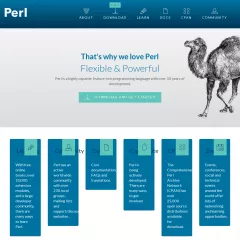
Perl is a high-level programming language that was originally developed by Larry Wall in the late 1980s. It was designed to be a versatile and powerful language for text manipulation and rapid prototyping. Perl stands for "Practical Extraction and Reporting Language."
Perl gained popularity for its ability to handle regular expressions, text processing, and system administration tasks. It provides powerful built-in features for pattern matching, string manipulation, file handling, and network programming. Perl also supports object-oriented programming, although it is primarily known for its procedural programming style.
Some key features of Perl include:
Regular Expressions: Perl has robust support for regular expressions, allowing developers to perform complex pattern matching and text manipulation operations easily.
Platform Independence: Perl is available on various platforms, including Unix, Linux, Windows, macOS, and others.
CPAN: The Comprehensive Perl Archive Network (CPAN) is a vast collection of modules and libraries that extend Perl's functionality. CPAN provides a wide range of ready-to-use modules for different purposes, which significantly simplifies development tasks.
Text Processing: Perl excels at text processing tasks, such as parsing and extracting data from files, manipulating strings, and transforming text data.
Flexibility: Perl offers a flexible programming style, allowing developers to choose between procedural, object-oriented, or functional programming paradigms.
Rapid Prototyping: Perl's concise syntax and powerful features make it suitable for quick prototyping and scripting tasks.
Over the years, Perl has influenced other programming languages, such as Python and Ruby, in terms of its focus on text manipulation and expressive syntax. However, its popularity has waned in recent years, with the rise of newer languages and frameworks. Nonetheless, Perl still has an active user community and continues to be used in various domains, particularly in system administration, bioinformatics, and network programming.
Perl gained popularity for its ability to handle regular expressions, text processing, and system administration tasks. It provides powerful built-in features for pattern matching, string manipulation, file handling, and network programming. Perl also supports object-oriented programming, although it is primarily known for its procedural programming style.
Some key features of Perl include:
Regular Expressions: Perl has robust support for regular expressions, allowing developers to perform complex pattern matching and text manipulation operations easily.
Platform Independence: Perl is available on various platforms, including Unix, Linux, Windows, macOS, and others.
CPAN: The Comprehensive Perl Archive Network (CPAN) is a vast collection of modules and libraries that extend Perl's functionality. CPAN provides a wide range of ready-to-use modules for different purposes, which significantly simplifies development tasks.
Text Processing: Perl excels at text processing tasks, such as parsing and extracting data from files, manipulating strings, and transforming text data.
Flexibility: Perl offers a flexible programming style, allowing developers to choose between procedural, object-oriented, or functional programming paradigms.
Rapid Prototyping: Perl's concise syntax and powerful features make it suitable for quick prototyping and scripting tasks.
Over the years, Perl has influenced other programming languages, such as Python and Ruby, in terms of its focus on text manipulation and expressive syntax. However, its popularity has waned in recent years, with the rise of newer languages and frameworks. Nonetheless, Perl still has an active user community and continues to be used in various domains, particularly in system administration, bioinformatics, and network programming.